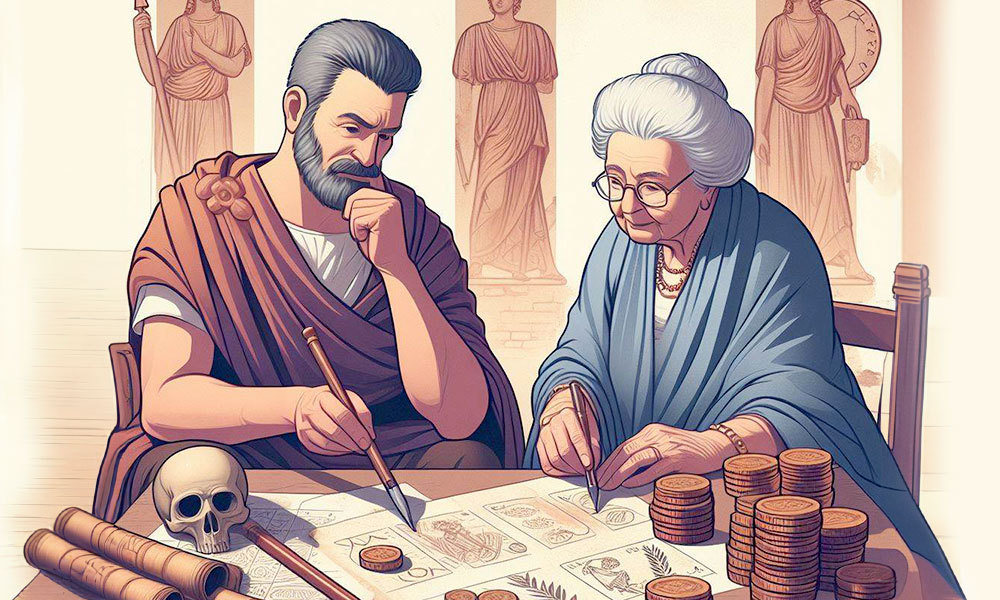Trusts are a cornerstone of estate planning, offering unparalleled flexibility and control in the management and distribution of assets. Their historical journey from ancient legal mechanisms to sophisticated modern-day estate planning tools underscores their significance and adaptability, making them an essential topic of understanding for anyone engaged in or planning for the transfer and management of assets.
A trust is essentially a fiduciary arrangement in which a third party, known as a trustee, is given the authority to hold and manage assets on behalf of one or more beneficiaries. This arrangement is pivotal in modern estate planning due to its flexibility and the diverse range of functions it can serve.
A trust is characterized by its unique structure where the ownership and control of assets are separated. The trustee, who holds legal title to the trust assets, is entrusted with the responsibility of managing these assets under the terms set out in the trust agreement. This management is done on behalf of the beneficiaries, who hold the equitable title to the trust assets. This separation of control and benefit is what defines the essence of a trust and is key to its many applications in estate planning.
What is the history of the development of trusts?
The role of trusts in estate planning is deeply rooted in history, reflecting a rich tapestry of legal and societal evolution. To fully appreciate the depth and significance of trusts in modern estate planning, it is essential to explore their historical journey.
The concept of trusts can be traced back to ancient Roman times. The Roman legal system included arrangements somewhat akin to trusts, known as “fideicommissum,” where property was entrusted to a faithful party to manage for the benefit of another. These early forms of trusts, developed and used roughly between the first century B.C. and the fourth century A.D. were rudimentary but laid the groundwork for more complex structures.

Trusts took on a more defined role in medieval England. During this era, the feudal system dominated land ownership, with strict rules on land transfer and inheritance. Trusts emerged as a creative legal solution to bypass these constraints. Landowners would transfer the legal title of their land to a trusted individual, who would manage it for the benefit of others, often the landowner's family. This arrangement allowed for greater flexibility in managing and passing on property.
The use of trusts in medieval England was partly a response to the rigid feudal system. Trusts provided a way to avoid feudal dues and inheritance restrictions, ensuring that land could be passed down to heirs or managed in a way that aligned with the landowner's wishes, rather than being dictated by feudal laws.
The use and enforcement of trusts led to the development of a separate system of law known as equity. Trusts were governed by principles of fairness and justice, as the common law (the law created by judges through court decisions) at the time was often too rigid to accommodate.
Many principles that were developed during medieval times to govern trusts continue to influence modern trust law. These include the concept of separating legal ownership (held by the trustee) from beneficial ownership (held by the beneficiary), the duty of the trustee to act in the best interests of the beneficiaries and the idea that trusts should be enforced according to the settlor's (creator of the trust) intentions.
The historical evolution of trusts from ancient Roman practices to their pivotal role in medieval English property law reveals their enduring relevance and adaptability. Trusts have been continually refined and adapted to meet changing societal, economic and legal needs, evolving from simple arrangements to complex structures that serve a variety of purposes in modern estate planning. Understanding this rich historical context is crucial for appreciating the full extent of the trust's role in contemporary estate planning strategies.
Trusts in the modern context
In contemporary times, the trust continues to evolve, responding to modern needs such as tax planning, asset protection and the complexities of managing diverse and often globalized estates. Understanding this historical evolution is not merely an academic exercise. It provides crucial insights into how and why trusts are used today. It sheds light on the enduring relevance of trusts in estate planning and their potential to address a wide range of modern-day estate planning challenges.
How have trusts evolved in the 20th and 21st centuries?
The 20th and 21st centuries have seen a remarkable expansion and refinement in trust law, marking a period of significant evolution from their historical roots. This era has been characterized by the adaptation of trusts to meet modern financial, legal and societal needs, with tax considerations and specialized trust types playing a pivotal role.

The aftermath of World War II marked a turning point in the use of trusts for estate planning, particularly in the context of tax planning. As tax laws became more complex and rates increased, trusts emerged as a strategic tool to minimize tax liabilities and maximize the preservation of wealth.
Trusts began to be strategically utilized to navigate the evolving tax landscape. By placing assets in certain types of trusts, individuals could reduce estate taxes, gift taxes and income taxes, thereby protecting more of their wealth for future generations.
One of the significant innovations in trust law is the development of special needs trusts. These trusts are designed to benefit individuals with disabilities, allowing them to receive inheritances or gifts without losing eligibility for vital government assistance programs like Medicaid or Supplemental Security Income (SSI).
Charitable trusts have gained prominence as a means to combine philanthropy with estate planning. Types such as charitable remainder trusts (CRTs) and charitable lead trusts (CLTs) offer tax benefits while allowing grantors to support charitable causes.
Living trusts, also known as revocable trusts, have become increasingly popular. These trusts are created during the grantor’s lifetime and can be altered or revoked as needed. They serve multiple purposes, including asset management during the grantor's life and avoiding probate upon their death.
Trusts in the modern era have adapted to the changing needs of society. This includes addressing issues like asset protection, care for aging populations and managing increasingly complex financial and family structures.
The impact of technology and globalization has also influenced trust law. The management of digital assets and international estate planning considerations are now part of trust planning.
Continuous legal innovations, along with challenges such as increased regulatory scrutiny and changes in international tax laws, have shaped how trusts are structured and administered.
In summary, the 20th and 21st centuries have been a period of significant growth and diversification for trusts in estate planning. From becoming sophisticated tools in tax strategy to evolving into specialized vehicles like special needs and charitable trusts, the adaptability of trusts has ensured their continued relevance in modern estate planning. This era has seen trusts evolve to meet the nuanced needs of contemporary society, solidifying their role as essential instruments in estate and wealth management.
What is the relationship between trusts and taxation?
The relationship between trusts and taxation is a crucial element of estate planning. Tax reforms over the years have directly impacted the use of trusts. As tax laws evolve, so do trust strategies, primarily to leverage tax benefits effectively. For instance, changes in estate tax laws can influence whether individuals opt for revocable or irrevocable trusts. Trusts have been adapted to navigate these tax changes, ensuring that they remain a viable tool for minimizing tax liabilities, preserving wealth and ensuring efficient wealth transfer. This dynamic nature of trust law underscores the importance of staying informed about tax legislation and its implications for trust-based estate planning.
What makes a trust so versatile as an estate planning tool?
Trusts are a powerful tool in estate planning capable of addressing a diverse range of needs and objectives. This versatility is grounded in the fundamental ability of trusts to be custom-tailored to the specific requirements and goals of the grantor (the individual establishing the trust). Let’s explore the various applications of trusts, highlighting their adaptability and significance in estate planning.

- Asset protection. Trusts are commonly utilized for their ability to safeguard assets from creditors, legal judgments and other financial liabilities that might impact the grantor or the beneficiaries directly. This is particularly beneficial for individuals in high-risk professions or those wanting to ensure that their wealth is preserved for future generations.
- Caring for minor or special needs beneficiaries. Trusts can be specifically structured to provide for beneficiaries who are minors or have special needs. For minors, a trust can manage and distribute assets for their benefit until they reach an age deemed suitable by the grantor. In the case of special needs beneficiaries, trusts can be designed to provide financial support without jeopardizing their eligibility for government assistance programs.
- Charitable giving. Charitable trusts are a popular means of facilitating philanthropy. These trusts allow individuals to earmark assets for charitable purposes, potentially yielding tax benefits while supporting causes important to the grantor. Charitable remainder trusts and charitable lead trusts are common structures used to balance charitable giving with other estate planning goals.
- Family business succession. Trusts play a crucial role in the seamless transition and management of family businesses from one generation to the next. By placing business interests in a trust, continuity can be ensured, and family disputes may be minimized. Trusts can provide clear guidelines for the future management and ownership of the business.
What distinguishes a revocable trust from an irrevocable trust?
Revocable trusts offer significant flexibility as they can be modified, or be completely revoked by the grantor during their lifetime. They also can help the grantor avoid guardianship in the event of incapacity. This flexibility is advantageous for grantors whose circumstances or intentions may change over time. Revocable trusts are also used for privacy and avoiding probate, as the assets in these trusts typically transfer directly to beneficiaries upon the grantor’s death, bypassing the public probate process.
In contrast, once an irrevocable trust is established, it generally cannot be altered. This permanence offers certain advantages, particularly in the context of asset protection and tax planning. Since the assets are effectively removed from the grantor’s estate, they are usually not subject to estate taxes. Additionally, irrevocable trusts are often used for Medicaid planning, helping individuals qualify for long-term care benefits without depleting their assets.
In summary, the versatility of trusts makes them a cornerstone in effective estate planning. Whether it's protecting assets, providing for loved ones, facilitating charitable giving or ensuring the longevity of a family business, trusts can be custom designed to meet a wide array of specific estate planning goals. This adaptability, combined with the choice between revocable and irrevocable structures, allows for a high degree of personalization in managing and securing one’s legacy.
Conclusion
From the ancient legal mechanisms of Rome to the intricate estate planning tools of today, trusts have demonstrated a remarkable capacity for evolution and adaptability. Their journey through history reflects not just legal developments but also shifting societal and economic landscapes. In the modern era, trusts continue to evolve, responding to contemporary needs such as tax planning, asset protection and managing diverse estates.
The 20th and 21st centuries have seen trusts become more sophisticated, diversifying into specialized types like special needs and charitable trusts. Their versatility in estate planning is evident through their ability to offer asset protection, care for beneficiaries, and facilitate family business succession. Trusts stand out for their adaptability, showcasing their enduring significance in estate planning and continuing to be pivotal in the management and transfer of wealth.



